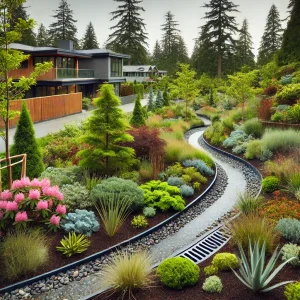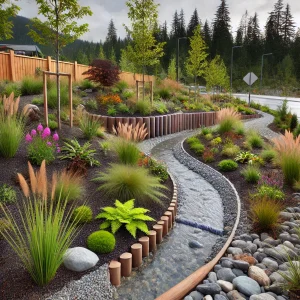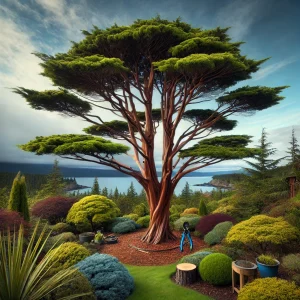As climate change intensifies, homeowners and landscapers in British Columbia increasingly need to adapt their landscapes to withstand extreme weather conditions. This blog explores how to create resilient landscapes that can endure droughts, storms, and other climate challenges. By implementing thoughtful strategies such as selecting native plants, installing effective drainage systems, and preparing trees for high winds, we can enhance the sustainability and longevity of our outdoor spaces.

Understanding Resilient Landscaping
Resilient landscaping is designing and maintaining outdoor spaces that can adapt to and thrive under varying environmental conditions. It involves creating landscapes that withstand climate extremes and contribute to the local ecosystem’s health. In British Columbia, where diverse climates range from coastal rainforests to arid interiors, it is crucial to tailor landscaping practices to local conditions.

Selecting Native Plants
One of the most effective strategies for creating resilient landscapes is selecting native plants. Native species are well-adapted to local soil, climate, and pest conditions, making them more likely to thrive without extensive maintenance. For example, in British Columbia, consider incorporating the following native plants into your landscape:
- Pacific Rhododendron (Rhododendron macrophyllum): Once established, this stunning evergreen shrub is beautiful and drought-tolerant. It provides a habitat for local wildlife and requires minimal care.
- Salal (Gaultheria shallon): A hardy ground cover that thrives in the shade, salal is excellent for erosion control and can withstand drought conditions once established. Its berries also provide food for birds.
By planting these native species, homeowners can create a resilient landscape that requires less water and maintenance while supporting local biodiversity.

Installing Proper Drainage Systems
Effective drainage is essential for preventing waterlogging during heavy rains and ensuring that plants receive adequate moisture during dry spells. Here are two strategies to consider:
- Rain Gardens: A rain garden is a shallow depression planted with native vegetation that captures and absorbs stormwater runoff. It helps mitigate flooding while providing a habitat for beneficial insects and birds. In British Columbia, incorporating plants like sword fern (Polystichum minimum) and red osier dogwood (Cornus sericea) can enhance the garden’s ecological benefits.
- Bioswales: Similar to rain gardens, bioswales are landscape elements designed to concentrate and convey stormwater. They typically feature a gently sloping design filled with native plants and gravel that can filter pollutants. By implementing bioswales, homeowners can reduce erosion and improve water quality in nearby streams and rivers.

Preparing Trees for High Winds
High winds during storms can cause significant damage to trees, leading to uprooting or broken branches. To prepare trees for these conditions, consider the following practices:
- Pruning Techniques: Regularly pruning trees can help reduce wind resistance. Focus on removing dead or weak branches and thinning out crowded canopies to allow wind to pass through more easily. This practice enhances the tree’s structural integrity and promotes healthy growth.
- Selecting Wind-Resistant Species: Some tree species are naturally more resilient to high winds. In British Columbia, consider planting Western Red Cedar (Thuja plicata), which is known for its durability and resistance to wind damage. Other options include Douglas Fir (Pseudotsuga menziesii) and Sitka Spruce (Picea sitchensis), also well-suited for the region’s climate.

Addressing Potential Challenges
While implementing these strategies can significantly enhance landscape resilience, homeowners may encounter challenges. For example, transitioning to native plants may require adjusting gardening habits, such as watering schedules and maintenance routines. Additionally, investing in drainage systems may involve upfront costs and planning.
To overcome these challenges, homeowners can start small—selecting a few native plants to replace non-native species or creating a single rain garden. Gradually expanding these efforts will make the transition more manageable and allow for more excellent adaptation. Engaging with local horticultural organizations or landscape professionals can provide valuable guidance and resources for successful implementation.
Creating resilient landscapes is essential for adapting to climate extremes and ensuring the sustainability of our outdoor spaces in British Columbia. By selecting native plants, installing proper drainage systems, and preparing trees for high winds, homeowners and landscapers can enhance their landscapes’ ability to withstand the impacts of climate change. With thoughtful planning and implementation, we can cultivate outdoor environments that thrive amidst the challenges of an increasingly unpredictable climate.
For more insights on creating resilient landscapes, consider exploring resources from the Ponte Vedra Recorder and the TurfMutt Foundation. These organizations offer valuable information and practical tips for adapting to climate extremes. Taking proactive steps today can build a more sustainable and resilient future for our communities.
